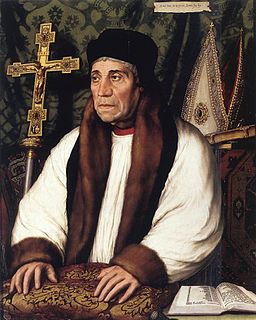Life
Buckmaster graduated at Peterhouse, Cambridge, B.A. in 1513–14, M.A. in 1517, B.D. in 1525, and D.D. in 1528. In 1517 he was elected fellow of his college. He served as vice-chancellor (terms starting in 1529, 1538, and 1539). [1] [2]
As vice-chancellor in 1529–30, Buckmaster took a prominent part in preparing replies to the questions referred by Henry VIII to the university about his divorce (the King's "great matter"). After discussion, Convocation resolved that marriage with a brother's wife was contrary to divine law, but the university declined to express an opinion on whether the Pope had power to permit such a marriage. This answer was not what the king desired, but Buckmaster was selected to carry it to Windsor and announce to Henry VIII the university's judgment. [1]
Buckmaster was twice elected Lady Margaret's Professor of Divinity (1532 and 1534). He became rector of Barcheston, Warwickshire (23 April 1530), and fellow of King's Hall (1532). He signed the Ten Articles of religion of 1536 as proctor in convocation of the London clergy; and about 1537 he was consulted by Thomas Cromwell, with many others, on the form which certain theological dogmas should take in the Anglican articles. He became prebendary of Hereford Cathedral (1539), and of St Paul's Cathedral, London (1541). He died shortly before 14 September 1545. Roger Ascham refers to Buckmaster as one of his Cambridge patrons. [1]

Thomas Cromwell,, briefly Earl of Essex was an English lawyer and statesman who served as chief minister to King Henry VIII from 1534 to 1540, when he was beheaded on orders of the king, who later blamed false charges for the execution.

Thomas Boleyn, Earl of Wiltshire, 1st Earl of Ormond, 1st Viscount RochfordKGKB, of Hever Castle in Kent, was an English diplomat and politician who was the father of Anne Boleyn, the second wife of King Henry VIII, and was thus the maternal grandfather of Queen Elizabeth I. By Henry VIII he was made a knight of the Garter in 1523 and was elevated to the peerage as Viscount Rochford in 1525 and in 1529 was further ennobled as Earl of Wiltshire and Earl of Ormond.

William Warham was the Archbishop of Canterbury from 1503 to his death.

William Paget, 1st Baron Paget of Beaudesert, was an English statesman and accountant who held prominent positions in the service of Henry VIII, Edward VI and Mary I.
John Bell LL. D was a Bishop of Worcester (1539–1543), who served during the reign of Henry VIII of England.
William Knight was the Secretary of State to Henry VIII of England, and Bishop of Bath and Wells.

Eustace Chapuys, the son of Louis Chapuys and Guigonne Dupuys, was a Savoyard diplomat who served Charles V as Imperial ambassador to England from 1529 until 1545 and is best known for his extensive and detailed correspondence.
Robert Beaumont was Master of Trinity College, Cambridge from 1561 to 1567 and twice Vice-Chancellor of the University of Cambridge. During this time, he commissioned Hans Eworth to copy the 1537 Hans Holbein portrait of King Henry VIII. This copy was bequeathed to Trinity College where it hangs to this day.
William Stewart was a late medieval Scottish prelate. Born around 1490 in Glasgow, he was the son of Thomas Stewart of Minto. Details about his early life are obscure, but it is known that he attended the University of Glasgow before travelling to continental Europe to study theology and canon law. The first benefice he held was the parsonage of Lochmaben, which he was in possession of by July 1528. In the same year he became rector of Ayr, while he had received crown presentation as Provost of Lincluden Collegiate Church in July 1529, a post he would hold along with his new position as Lord High Treasurer of Scotland.
Stephen Vaughan (1502-1549) was an English merchant, royal agent and diplomat, and supporter of the Protestant Reformation.
Sir Nicholas Hare of Bruisyard, Suffolk was Speaker of the House of Commons of England between 1539 and 1540.
John Oliver was an English churchman, canon lawyer, courtier and Dean of Christ Church, Oxford.
Anthony Belasyse, also Bellasis, Bellows and Bellowsesse was an English churchman and jurist, archdeacon of Colchester from 1543.
Peter Vannes was an Italian Catholic churchman who became a royal official in England, and Dean of Salisbury.

John Edmunds was master of Peterhouse, Cambridge.
Simon Haynes or Heynes was Dean of Exeter between 1537 and 1552.
Richard Woleman or Wolman was an English churchman, Archdeacon of Sudbury from 1522; and the Dean of Wells between 1529 and 1537.
Sir James Colville of Easter Wemyss was a Scottish administrator, lord of session and diplomat.
William Cliffe, Clyffe or Clyff was an English churchman and lawyer, dean of Chester from 1547.
Nicholas Hawkins, LL.D. (c.1495–1534) was an English cleric and diplomat.
This page is based on this
Wikipedia article Text is available under the
CC BY-SA 4.0 license; additional terms may apply.
Images, videos and audio are available under their respective licenses.
![]() This article incorporates text from a publication now in the public domain : Stephen, Leslie, ed. (1886). "Buckmaster, William". Dictionary of National Biography . Vol. 7. London: Smith, Elder & Co.
This article incorporates text from a publication now in the public domain : Stephen, Leslie, ed. (1886). "Buckmaster, William". Dictionary of National Biography . Vol. 7. London: Smith, Elder & Co.




